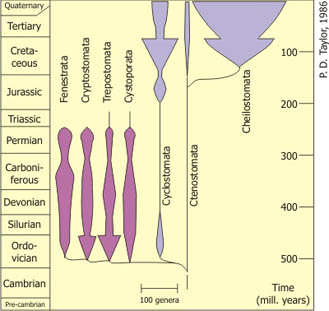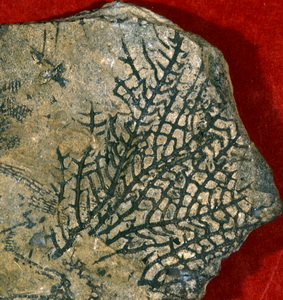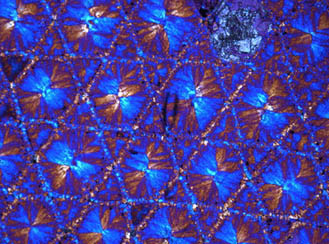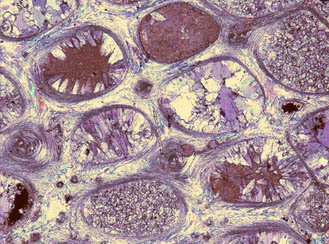1. Svalbard
Bryozoans are a diverse exclusively colonial phylum of invertebrates with a rich fossil history extending back to the Early Ordovician. The great majority of bryozoans live in the sea and secrete hard skeletons composed of calcium carbonate. Palaeozoic bryozoans are commonly studied in petrographic thin sections or acetate peels, and detailed characters are identified using light or scanning electron microscope.
The main aims of the Svalbard bryozoan research project are:
- To describe and document the taxonomic composition of the fossil bryozoan faunas from Middle Carboniferous (Moscovian) through Lower Triassic (Dienerian-Smithian) rocks in Svalbard.
- To outline the biostratigraphic distribution of individual taxa, and their correlation with well-known Upper Palaeozoic-Lower Triassic sections elsewhere.
- To map the distribution of recognized growth forms of the bryozoan colonies in relation to variation in depositional environments and their use in palaeogeographical interpretations.
Biostratigraphy: Many studied bryozoan taxa prove to have short vertical distributions, often controlled by changes in the depositional settings. The ranges often parallel ranges in well-studied sections in Russia, but some taxa are found to have occurrences outside previously defined ranges
Palaeoecology: Bryozoans are sessile colonial organisms which reflect depositional environments and physical factors in the shape of their colony. Many factors control their growth including water energy levels, which often is reflected in distance from land and water depth.
In Svalbard the shallowest settings, with evaporitic(?) and lagoonal sedimentation contain low diversity faunas. Deeper settings, with both siliciclastic and carbonaceous sedimentation contain the most diverse faunas. Palaeoaplysinid and algal buildups apparently housed few bryozoans, whereas a build-up of Moscovian age contained almost 100% fenestrate bryozoans. Robust stick-like and fenestrated bryozoans dominate the shallow deposits, whereas delicate trepostomes, cryptostomes and fenestrates occur in highest proportions in the deeper, siliciclastic settings.
Palaeobiogeography: The Spitsbergen bryozoan faunas show great similarities with respect to time-equivalent faunas described from adjacent palaeo-basins, notably the Timan-Pechora Basin, the Wandel Sea Basin, the East Greeland Basin and the Sverdrup Basin. The Early Permian faunas of Spitbsergen are very much like those from the central and southern Urals and the Russian Platform, but the similarity decreases during the later stages of the Early Permian. The Tethyan faunas on the other hand are consistently very different from the northern faunas. During the Late Permian almost identical faunas developed in Svalbard and Novaya Zemlya. This pattern reflects the closing of the Uralian Sea, and the separation of the northern basins from the Tethys Sea, and the Late Permian cooling and northern movement of the Svalbard Platform. Bryozoans are extremely rare in Lower Triassic successions worldwide, and only two genera (Paralioclema and Arcticopora) are found in Spitsbergen.




Selected references
- Ernst, A. & Nakrem, H.A. 2007. Lower Permian Bryozoa from Ellesmere Island (Canada). Palaeontologische Zeitschrift 81, 17-28
- Nakrem, H. A. 1994a. Middle Carboniferous-Lower Permian bryozoans from Spitsbergen. Acta Palaeontologica Polonica 39 (1), 45-116.
- Nakrem, H. A. 1994b. Environmental distribution of bryozoans in the Permian of Spitsbergen. In: Hayward, P. J., Ryland, J. S. & Taylor, P. D. (eds): Biology and Palaeobiology of Bryozoans. 133-137. Olsen & Olsen, Fredensborg.
- Nakrem, H. A. 1995. Bryozoans from the Lower Permian Vøringen Member (Kapp Starostin Formation), Spitsbergen (Svalbard). Norsk Polarinstitutt Skrifter 196, 92 pp. [Dated 1994]
- Nakrem, H. A. 2002. A Moscovian (Carboniferous) bryozoan buildup from Svalbard. In: Wyse Jackson, P., Buttler, C. & Spencer Jones, M. (Eds.) Bryozoan Studies 2001, 239-245. Swets & Zeitlinger, Lisse.
- Nakrem, H. A. 2005. Some middle Permian bryozoans from Svalbard , Arctic Norway. In: Bryozoan Studies 2004, 197-205. Great Britain: Taylor & Francis Books.
- Nakrem, H. A. 2008. Fossil Bryozoa from Svalbard (Arctic Norway) ? a research history. In: Annals of Bryozoology 2: aspects of the history of research on bryozoans. 71-88. Dublin: International Bryozoology Association. ISBN 0-9543644-1-4.
- Nakrem, H.A. & Ernst, A. 2008. Arcticoporidae fam. nov. (Bryozoa, Trepostomata) from the Lower Triassic of Ellesmere Island (Canada) with remarks on some other Triassic bryozoans. In: Bryozoan Studies 2007. Proceedings of the 14th International Bryozoology Association Conference, Boone, North Carolina. 143-152. Virginia, USA: Virginia Museum of Natural History.
- Nakrem, H. A. & Mørk, A. 1991. New Early Triassic Bryozoa (Trepostomata) from Spitsbergen, with some remarks on the stratigraphy of the investigated horizons. Geological Magazine 128, 129-140.
- Nakrem, H. A. & Spjeldnæs, N. 1995. Ramipora hochstetteri Toula, 1875 (Bryozoa, Cystoporata), from the Permian of Svalbard. Journal of Paleontology 69 (5), 831-838.
2. Arctic Canada (Ellesmere Island), Vancouver Island and North America ( Alaska )
NHM-forsker: Hans Arne Nakrem
Tilknyttede forskere: Benoit Beuchamp, Charles M. Henderson, Erik Katvala (Calgary)
Bryozoans are among the most diverse and most common fossils in Carboniferous and Permian rocks of the present day Canadian Arctic (the Sverdrup basin). Here, as well as in Svalbard and Greenland, bryozoans are known to form small to medium sized reefs and bioherms, and they are distributed in large numbers especially in the carbonate rocks in these areas. The upper Paleozoic succession of the Sverdrup Basin, which is up to 5 km thick, is characterized by eight long-term sequences bounded by major unconformities at the basin margin, passing basinward into correlative conformities.
A significant collection of petrographic thin sections has been studied (originally prepared for various MSc and PhD studies during the last 25 years). Some samples have been thin sectioned for the current study to obtain oriented views of the bryozoans. Due to preservation problems (dolomitization and silicification) acetate peels did not provide the expected results.
The following formations (and their ages) have been studied: Raanes Fm. (Sakmarian), 27 genera; Great Bear Cape Fm. (Artinskian) > 35 genera; Sabine Bay Fm. (Kungurian) <10 genera; Assistance Fm. (Roadian - lower Wordian) 15 genera; Van Hauen Fm. (Roadian-Wuchiapingian) 5 genera; Trold Fiord Fm. (Wordian-Wuchiapingian) 16 genera; Degerböls Fm. (Wordian-Capitanian) 7 genera; Lindström Fm. (Wuchiapingian), 14 genera.
The generic composition is similar to time-equivalent units of Greenland, Svalbard, Novaya Zemlya and northern Russia, but also to Tethyan faunas during the Early Permian. Some rather common genera in Svalbard and Russia (e.g. Coscinium and "Ascoporella", sensu Morozova & Kruchinina (1986)) are absent in the investigated material from the Sverdrup basin. Some genera have an older first occurrence in the Sverdrup basin (e.g. Permoheloclema, Primorella, Clausotrypa) as compared with the Svalbard area, whereas others found in the Sverdrup basin (e.g. Spinofenestella, Phragmophera and Stenophragmidium) are absent from the Svalbard/Russian equivalents. It should also be noted that the youngest Permian faunas of Svalbard are older than the youngest Permian faunas of the Sverdrup Basin. The distribution revealed so far will be presented in paleobiogeographic and biostratigraphic contexts.


